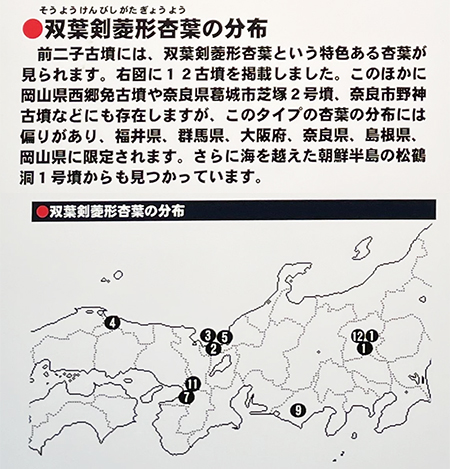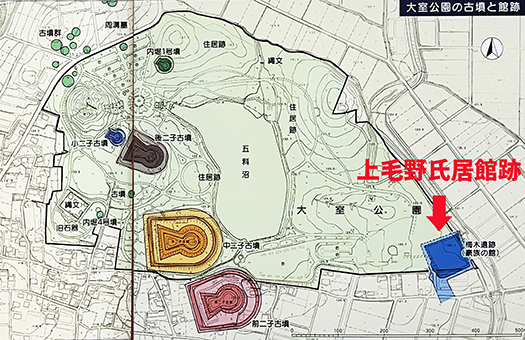


上毛野氏というのは、古代日本史のなかで大きなプレーヤー。
渟〜ちぬの国と呼ばれた現在の堺などから泉南といわれる地域を
スタート地点にして東征の道筋そのまま、勢力を拡大させて
それぞれの地域で分家が進んでいったように思える。
白村江海戦(663年8月27日)の時期には上毛野稚子(わくご)は
新羅討伐「副将軍」として新羅に渡った。
普通に考えるとその軍勢を編成しまとめることに功績があった。
ヤマト政権としての新規支配地域・板東の勢力を糾合して
派遣軍全体において重要な立場だったといえるのだろう。
それだけの王権からの信頼と権益実態があったことも確かだと思う。
この時代の国際戦争、将軍役とは現地での交渉なども自由裁量があっただろうし、
また韓半島地域で人脈なども形成していたと考えるのが自然。
とくに白村江敗戦以降、百済の王民が多数、日本列島に帰化している。
かれらは当時の日本列島社会では識字率や教育水準でも先進性があり、
その後、記紀編纂や奈良期の律令国家体制成立にも主導的に関わった。
こうしたかれらとの繋がりも上毛野氏は強かったと思える。
この上毛野氏関連の古墳から出土する考古発掘物からは
「双葉剣菱杏葉」形状のものが特徴的に確認されるのだという。
いわば氏族の「アイコン」というように推定できるということ。
その古墳群が国内で12基確認され、図に示した。
上毛野氏の起源地とされる泉南地域、北陸地域、そして群馬県などに確認され、
なんと、韓半島「松鶴洞1号墳」からも確認されているとのこと。
松鶴洞は釜山の近郊地域。
上毛野氏の事跡として崇神天皇(553-592年)のときに上毛野久比という人物が
中国の呉の国に派遣されて帰朝後、計量器「秤」を天皇に渡している。
秤の日本社会への導入初見とされている。
日本書紀の記述だが三国時代の呉(222-280年)とは時代的なズレがある。
解釈すれば呉の国と通称した地域名ということだろうか。
ちなみにこの崇峻天皇は蘇我氏に暗殺された天皇。
いずれにしても、上毛野氏が大陸や半島交流で重要な役割だったことは間違いない。
古代の纏向や飛鳥時代当時の王権の生々しい内情がうかがえる。
とくに強く興味を持たされるのが、韓半島での「古墳文化」との関連性。
韓半島では「前方後円墳」が南西部局限で現存するというが、
日本国内でも時限的に出現するこの古墳タイプが
韓国国内でなぜ出現するのか、多くの事実を証していると思える。
普通に考えればヤマト王権はこうした地域に権益を保持していて
その権益との関係で百済と強い紐帯関係を持っており、
その流れで当時の「世界大戦」白村江海戦に参戦したものだろう。
副将軍だった上毛野氏は古代史のなかでも重要な氏族といえるでしょうね。
English version⬇
Traces of the Yamato Royal Family’s Political Wars: Exploration of the “Kamitukeno Clan”-3
The distinctive icons of the clan have been confirmed in 12 domestic burial mounds and in a burial mound on the Korean peninsula. Is this evidence that they were the main players in ancient political battles? …
The Kamitukeno clan is a major player in ancient Japanese history.
They started from the area called Chinu-no-kuni, which is now known as Sennan from Sakai and other areas.
The Kamitukeno clan started out in the area known as “Chinu-no-kuni” and expanded their power along the path of the Eastern Expedition.
The division of the clan seems to have progressed in each region.
At the time of the Battle of Hakusukie (August 27, 663), Wakugo Kamitukeno was
went to Silla as a “vice general” to defeat Silla.
He was usually credited with organizing and consolidating that army.
He was in an important position in the overall dispatch of the army, denouncing the forces of Bando, the newly controlled area of the Yamato regime.
It could be said that he was in an important position in the entire dispatched army.
I think it is also certain that he had that much trust from the royal authority and the reality of his interests.
In the international wars of this era, the generals would have had free reign to negotiate in the field, and they would have had personal connections in the Korean peninsula.
It is also natural to assume that he had formed personal connections in the Korean peninsula.
In particular, after the defeat at the Paekchon River, many Baekje royalty were naturalized in the Japanese archipelago.
They were advanced in terms of literacy rate and education level in the Japanese society at that time.
Later, they played a leading role in the compilation of the Chronicles of Japan and the establishment of the Ritsuryo (law and order) state system in the Nara period.
It is likely that the Kamitukeno clan had strong ties with these people.
Archaeological artifacts excavated from burial mounds related to the Kamomono Clan have been found to contain the following items
The archaeological excavations from the burial mounds related to the Kamitukeno Clan are characterized by the shape of the “double-leafed sword-rhombus leaf”.
It can be presumed that this is an “icon” of the clan, so to speak.
Twelve such tumuli have been identified in Japan and are shown in the figure.
They are located in the Sennan area, the Hokuriku area, and Gunma Prefecture, where the Kamitukeno clan is said to have originated.
The tombs have also been confirmed from “Songhak-dong No. 1” on the Korean peninsula.
Songhak-dong is a suburb of Busan.
The Kamitukeno clan is known to have been founded by a man named Kubi Kamimono during the reign of Emperor Sojin (553-592).
He was sent to Wu, China, and upon his return to Japan, he gave the emperor a scale, a measuring instrument.
This is said to be the first time that scales were introduced into Japanese society.
Although this is a description from the Nihon Shoki, there is a time gap with Wu (222-280) of the Three Kingdoms period.
The name of the region commonly referred to as the Land of Wu may be interpreted as the name of the region.
Incidentally, this Emperor Soshun was the emperor who was assassinated by the Soga clan.
In any case, there is no doubt that the Kamitukeno clan played an important role in continental and peninsular exchanges.
This book gives us a vivid picture of the inner workings of the royal power at the time of the ancient Sumo Makumuki and Asuka periods.
Of particular interest is the connection with the “kofun culture” of the Korean peninsula.
In the Korean Peninsula, “forward-rear circular tombs” are said to exist only in the southwestern part of the peninsula.
Why do these burial mounds, which also appear in Japan on a limited basis, appear in Korea?
This is a proof of many facts as to why this burial mound type appears in Korea.
It is usually thought that the Yamato royalty had interests in these areas, and that Baekje was a part of the Yamato royalty.
The Yamato kingdom had strong ties with Baekje in relation to its interests in these areas, and this was the reason for the “World War” of the time.
This is probably the reason why they participated in the “World War” of the time, the Battle of Hakusukie.
The Kamitukeno clan, who were vice generals, are probably one of the most important clans in ancient history.
Posted on 8月 12th, 2022 by 三木 奎吾
Filed under: 日本社会・文化研究, 歴史探訪







コメントを投稿
「※誹謗中傷や、悪意のある書き込み、営利目的などのコメントを防ぐために、投稿された全てのコメントは一時的に保留されますのでご了承ください。」
You must be logged in to post a comment.